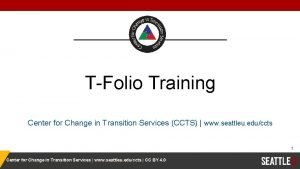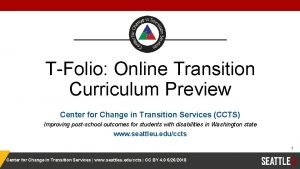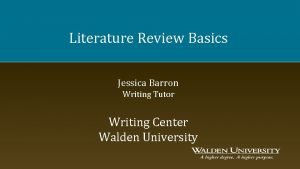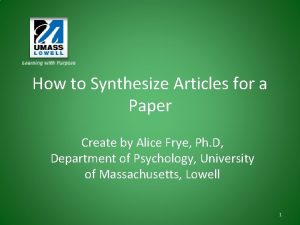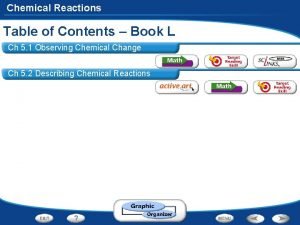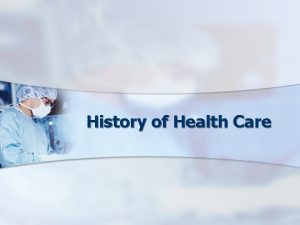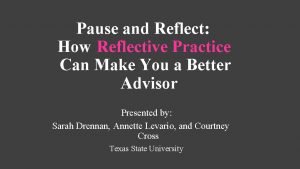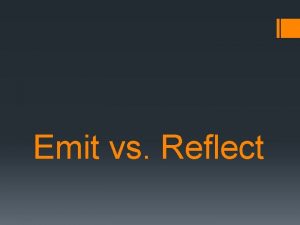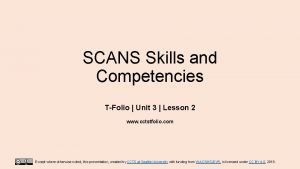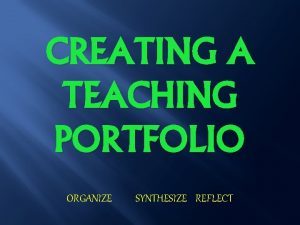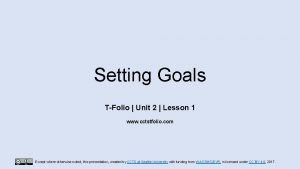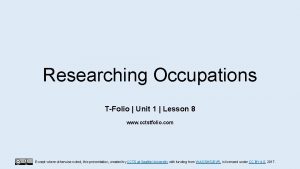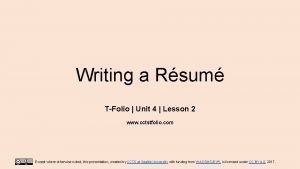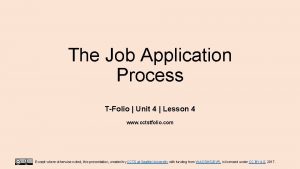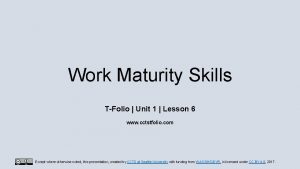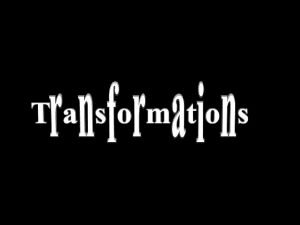Synthesize and Reflect TFolio Unit 1 Lesson 7









- Slides: 9

Synthesize and Reflect T-Folio | Unit 1 | Lesson 7 www. cctstfolio. com Except where otherwise noted, this presentation, created by CCTS at Seattle University with funding from WA DSHS/DVR, is licensed under CC BY 4. 0, 2017.

Lesson Objectives You will: 1. Analyze and combine connected traits relating to strengths, needs, interests, and preferences. 2. Describe and illustrate how identified traits represent self. 3. Complete the Synthesizing Assessment Results: Bringing it all Together worksheet. Except where otherwise noted, this presentation, created by CCTS at Seattle University with funding from WA DSHS/DVR, is licensed under CC BY 4. 0, 2017.

Warm-up Questions • Have you ever tried to put together a 500+ piece jigsaw puzzle? • What strategies did you use to put it together? • What skills are you using when putting the puzzle together? • Was it challenging? In what ways? Except where otherwise noted, this presentation, created by CCTS at Seattle University with funding from WA DSHS/DVR, is licensed under CC BY 4. 0, 2017.

Synthesizing • Learning about your interests, needs, preferences, and strengths takes a good deal of thought, self-awareness, and reflection. • You will be analyzing your assessment results by connecting your information and ideas to put together a fuller picture of you – a step closer to identifying what you want in life – now and in the future. • This process is called synthesizing. Except where otherwise noted, this presentation, created by CCTS at Seattle University with funding from WA DSHS/DVR, is licensed under CC BY 4. 0, 2017.

Activity Open Synthesizing Assessment Results: Bringing It All Together. Except where otherwise noted, this presentation, created by CCTS at Seattle University with funding from WA DSHS/DVR, is licensed under CC BY 4. 0, 2017.

Directions For each of the sections (strengths, needs, preferences, and interests), do the following: 1. Select the appropriate assessments and/or tools you will be using to complete the section. Do one section at a time! 2. As you review the tools results, highlight or circle those items that represent the traits pertaining to you 3. Review the traits you have highlighted or circled and group them into categories (i. e. , social, technical, work conditions, specialty skills, etc. ). Enter those categories in the Trait Category column. There are no wrong category labels; create ones that make sense to you! Except where otherwise noted, this presentation, created by CCTS at Seattle University with funding from WA DSHS/DVR, is licensed under CC BY 4. 0, 2017.

Directions (continued) 4. In the Common Traits column, list 3 -5 common or connected traits that align to each category from your highlights. 5. In the Combined Trait column, combine all the aspects into one phrase or statement. 6. In the last column, explain how the combined trait reflects you and give an example of how it displays itself in your life. 7. Complete a minimum of three Trait Categories for each section. 8. Finally, for each section, name the assessments and/or tools used in the space provided. Except where otherwise noted, this presentation, created by CCTS at Seattle University with funding from WA DSHS/DVR, is licensed under CC BY 4. 0, 2017.

Debrief & Guiding Questions • As a result of this work, what new insights do you have about yourself? • How might the information learned better inform you in identifying future goals in work, education, independent living? Except where otherwise noted, this presentation, created by CCTS at Seattle University with funding from WA DSHS/DVR, is licensed under CC BY 4. 0, 2017.

Licensing & Copyright External links This resource may contain links to websites operated by third parties. These links are provided for your convenience only and do not constitute or imply any endorsement or monitoring. Please confirm the license status of any third-party resources and understand their terms of use before reusing them. Licensing Except where otherwise noted, this work, created by Center for Change in Transition Services at Seattle University with funding from Washington State Division of Social and Health Services/Division of Vocational Rehabilitation, is licensed under a Creative Commons Attribution License. All logos and trademarks are property of their respective owners. For more details on T-Folio’s licensing policy, please visit: www. cctstfolio. com
